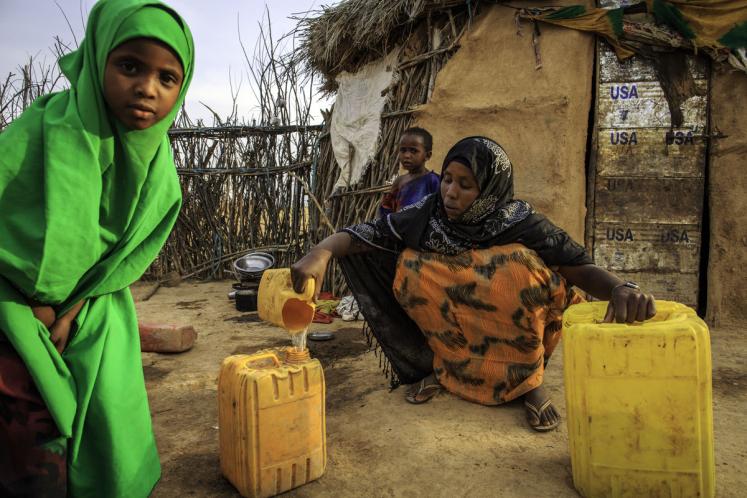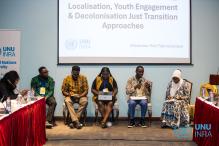A few weeks ago in New York, I was honoured to present a paper to ECOSOC on the governance of the UN Development System in the post-2015 era. While this is a somewhat dry topic, we at CPR are quite passionate about effective governance.
Why? Because the United Nations is a Member State Organization and is at its most effective when the Member States are truly engaged with its actions. This is true from peacekeeping through peacebuilding; from emergency response through development. And many of the systemic flaws in the United Nations (human resources, financing) that limit its ability to effectively carry out mandates, are a function of governance systems that could be improved.
The thrust of the paper is simple. The governance arrangements of the UN Development System (UNDS) are a patchwork. The form of governance has only little relationship to function; it is not even clear what the desired functions would be.
As a result, the UNDS is subject to governance arrangements that are the result of a complex history of negotiations among Member States. The outcomes of these negotiations were reflective of particular moments in history in terms of the role of the UN, the relationships between the Member States, and broader global power dynamics. And for three basic reasons, change is necessary:
-
The significant increase in the number of Member States, and the changes in global economic and power distributions that affect the legitimacy of representation.
-
The proliferation of non-UN actors working in development, including the private sector, foundations, actors from newly industrialized and industrializing countries, and the global explosion of civil society actors.
-
Perhaps most compelling is that the SDG’s represent a different order of tasks for the UNDS. One of the few papers to analyze the question of governance in the post-2015 context has argued: “the SDG agenda demands an evaluation of the acceptable bounds of natural, human and human-produced capital… SDG governance architecture is not simply a realm of harmonizing interests in pursuit of coordination. It is also going to require a serious engagement with politics and power.”1
Past efforts at addressing the complexity of sustainable development have failed.2 And it remains, at this point, unclear what role Member States foresee for the UNDS, despite some consensus emerging after the General Assembly-based Open Working Group (OWG) process. The paper highlights a few tensions that will pose a challenge in September:
-
The tension between the global and the local:This is already a challenge as Member States call for both greater field-level decision-making and greater scrutiny. Yet, as a recent network analysis of the draft SGDs identified, the most “networked” or linked targets are those around ensuring sustainable consumption and production (Goal 12) and reducing inequality (Goal 10).3Addressing these issues will require concerted efforts at the country level as well as robust global frameworks and agreements. How will the UNDS governance structure respond?
-
A new role/new norms: Related to the global/local tension, the increasing role of new actors, and the emergence of new institutional structures, such as vertical funds, the governance architecture will have to identify what its role is in setting norms, and in propagating standards and goals for achieving the SDGs to other actors. In particular, it will have to reflect on how, in areas where the UN has limited direct influence, it should (or should not) play a role.
-
Managing new, universal models of engagement: The role of the UNDS will have to vary widely within different contexts if the post-2015 agenda is to be truly universal. A particular challenge will be identifying an appropriate role in middle-income countries, and finding a governance mechanism that can support this engagement. Cross-border work, from regional approaches, to South-South, North-South and triangular cooperation will all demand appropriate regimes of governance.
Our paper also notes two other complicating factors:
-
The easy wins have already been won: The call for no one to be left behind stems from the recognition that people have been left behind by the tremendous development gains of the last few decades. Yet serious analytical work by The Brookings Institution has identified that the countries with elevated poverty rates and poor records of progress on poverty reduction – countries that host the majority of the world’s remaining poor – “face one or more structural challenges to inclusive growth: they are small or land-locked, have bad neighbors, are disaster- or disease- prone or have a record of bad governance or conflict.”4 The authors, who include the research director for the High Level Panel on the Post-2015 Development Agenda, conclude that “getting to zero poverty by 2030 requires that each of these countries defies its circumstances and, in some cases, match or better the fastest recorded poverty reduction trajectories from history.”For the UNDS to deliver against these circumstances will require an effective, skilled, and well-governed system. It will also require the system to manage the tension between championing both global best practices and locally appropriate solutions, while operating at a convincing scale. This will require the governance architecture to resolve the tensions between the global and the local, and to find a way to support the system to manage challenges – such as the effects of climate change – that have tremendous local impacts, but require global solutions.
-
The declining role of the UN in development: The elephant in the room is that the UN simply matters less than it used to in development. This is a function of scale – the relative amounts of resources available through ODA are simply a small fraction of other resource flows – whether through FDI, remittances, or even portfolio equity flows.5 The percentage of ODA flowing through the UN system, once humanitarian assistance is removed, is also declining in absolute terms and declining relative to the international financial institutions, Regional Development Banks, and non-UN (or UN-controlled) bodies, including emerging ones such as the new Asian Infrastructure Investment Bank. At the same time, the role of the UN as a whole and the UNDS appears to be concentrating in a particular set of contexts – in the face of fragility and conflict – where it may be more important than ever.
This raises serious governance questions. If the UNDS, for the majority of countries, is to move from a role of programming to a role of partnerships and leveraging private flows, it will require a mechanism for relations with new actors – the private sector, foundations, capital flows, and even individuals. The struggle over the partnerships facility in New York highlights the absence of Member State consensus on how to address this issue. Yet there will also be a need for a different model of governance operating in states where the UNDS plays a significant operational role.
The paper goes on to explore the problems of assessing governance. As we do not have the capability of assessing the performance of the Development System as a system, we simply cannot assess the performance of the governance structures. It suggests a few areas for improvement, particularly on accountability, on clarity, and on integrity.
But mostly, it raises seven questions that we think Member States must grapple with in order to move forward:
-
What are the new functions that the SDGs will require of the governance of the UNDS? Can these functions be performed through incremental changes to the system, or is a fundamental re-think required?
-
Do Member States envisage an increasing or decreasing operational role for the UNDS? Is this different from the normative role they desire for the UNDS? What is the impact of this on governance? How will the governance architecture reconcile its role in norm setting at the global level with the continued need for highly localized programming?
-
How does the governance architecture manage partnerships? How do Member States foresee its role in ‘leveraging’ – where the UNDS is working with external sources of financing, but trying to achieve common goals?
-
What is the role of the UNDS governance structure in evidence-based policy making? What are the capacities that the system requires to effectively fulfill such functions if desired?
-
What are Member States willing to pay for governance? How much should it cost?
-
How does an effective governance system ensure adequate oversight and accountability without getting overly involved in management? What should the inter-governmental process never do, and what should never happen without inter-governmental approval?
-
Given the answers to these questions, what is the right basis for representation? Is there a tension between representation and effectiveness? Given the response to this, does the UNDS system derive more legitimacy in this new era from greater representation, or from greater effectiveness?
For more detail, please read the full paper!
1 Dasandi, Nibeer et al., “Post-2105 Development Agenda Setting in Focus: Governance and Institutions” forthcoming in J. Waaage & C. Yap, Thinking Beyond Sectors for Sustainable Development (London: Ubiquity Press, forthcoming 2015), p. 10.
2 Wilkins, Hugh. "The Integration of the Pillars of Sustainable Development: A Work in Progress" accessed at https://www.mcgill.ca/jsdlp/files/jsdlp/4_2_3_wilkins_2.pdf.
3 LeBlanc, David. “Towards integration at last? The sustainable development goals as a network of targets” DESA Working Paper No. 141; ST/ESA/2015/DWP/141.
4 http://www.usaid.gov/frontiers/2014/publication/section-1-last-mile-ending-extreme-poverty. For more information on the Last Mile project, please see http://www.brookings.edu/research/books/2014/the-last-mile-in-ending-extreme-poverty
5 Jenks, Bruce, and Jones, Bruce, “United Nations Development at a Crossroads.” Center on International Cooperation. New York, 2013, p. 14.
Suggested citation: "Let’s Start at the Very Beginning: Governing the UN Development System in the Age of Sustainable Development," UNU-CPR (blog), 2015-06-29, https://unu.edu/cpr/blog-post/lets-start-very-beginning-governing-un-development-system-age-sustainable-development.



